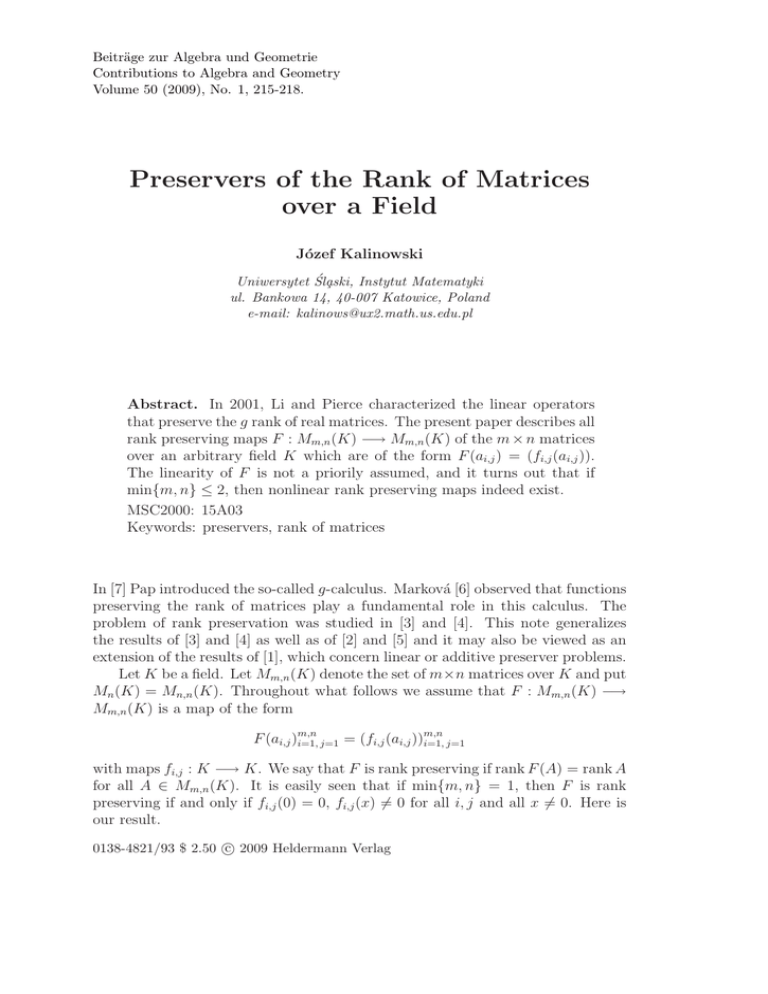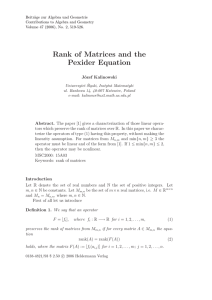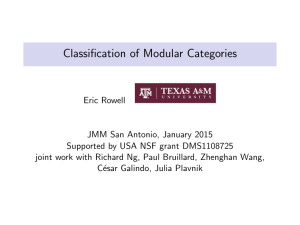Beitr¨ age zur Algebra und Geometrie Contributions to Algebra and Geometry
advertisement

Beiträge zur Algebra und Geometrie
Contributions to Algebra and Geometry
Volume 50 (2009), No. 1, 215-218.
Preservers of the Rank of Matrices
over a Field
Józef Kalinowski
Uniwersytet Śla̧ski, Instytut Matematyki
ul. Bankowa 14, 40-007 Katowice, Poland
e-mail: kalinows@ux2.math.us.edu.pl
Abstract. In 2001, Li and Pierce characterized the linear operators
that preserve the g rank of real matrices. The present paper describes all
rank preserving maps F : Mm,n (K) −→ Mm,n (K) of the m × n matrices
over an arbitrary field K which are of the form F (ai,j ) = (fi,j (ai,j )).
The linearity of F is not a priorily assumed, and it turns out that if
min{m, n} ≤ 2, then nonlinear rank preserving maps indeed exist.
MSC2000: 15A03
Keywords: preservers, rank of matrices
In [7] Pap introduced the so-called g-calculus. Marková [6] observed that functions
preserving the rank of matrices play a fundamental role in this calculus. The
problem of rank preservation was studied in [3] and [4]. This note generalizes
the results of [3] and [4] as well as of [2] and [5] and it may also be viewed as an
extension of the results of [1], which concern linear or additive preserver problems.
Let K be a field. Let Mm,n (K) denote the set of m×n matrices over K and put
Mn (K) = Mn,n (K). Throughout what follows we assume that F : Mm,n (K) −→
Mm,n (K) is a map of the form
m,n
F (ai,j )m,n
i=1, j=1 = (fi,j (ai,j ))i=1, j=1
with maps fi,j : K −→ K. We say that F is rank preserving if rank F (A) = rank A
for all A ∈ Mm,n (K). It is easily seen that if min{m, n} = 1, then F is rank
preserving if and only if fi,j (0) = 0, fi,j (x) 6= 0 for all i, j and all x 6= 0. Here is
our result.
c 2009 Heldermann Verlag
0138-4821/93 $ 2.50 216
J. Kalinowski: Preservers of the Rank of Matrices over a Field
Theorem.
(a) If min{m, n} = 2, then F is rank preserving on Mm,n (K) if and only if there
exist nonzero u1 , u2 , . . . , um , v1 , v2 , . . . , vn ∈ K and an injective function g :
K −→ K satisfying g(0) = 0 and g(xy) = g(x)g(y) for all x, y ∈ K such
that fi,j (x) = ui vj g(x) for all x ∈ K.
(b) If min{m, n} ≥ 3, then F preserves the rank on Mm,n (K) if and only if
there are nonzero u1 , u2 , . . . , um , v1 , v2 , . . . , vn ∈ K and an injective function
g : K −→ K satisfying g(xy) = g(x)g(y) and g(x + y) = g(x) + g(y) for all
x, y ∈ K such that fi,j (x) = ui vj g(x) for all x ∈ K.
Thus, for min{m, n} ≥ 3 the rank preserving maps F on Mm,n (K) may be
written in the form F (A) = U [g(ai,j )]V , where U = diag(u1 , u2 , . . . , um ) and
V = diag(v1 , v2 , . . . , vn ) are invertible diagonal matrices and g is an injective endomorphism of K. For min{m, n} = 2, the additivity of g may even be relaxed
to the sole requirement that g(0) = 0. Note that the maps of part (a) may be
nonlinear: for example, one can take g(x) = x3 .
Proof. Let min{m, n} ≥ 2 and suppose F is rank preserving on Mm,n (K). We
denote by Ej,k the matrix whose j, k entry is 1 and the remaining entries of which
are 0. Since rank F (xEi,j ) = rank xEi,j , we see that fi,j (0) = 0 and fi,j (x) 6= 0 for
all i, j and all x 6= 0. The matrix all entries of which are 1 has rank 1, and since F
preserves the rank of this matrix, it follows that rank (fi,j (1)) = 1. This implies
that there are ui , vj ∈ K such that fi,j (1) = ui vj for all i, j. Because fi,j (1) 6= 0,
−1
we obtain that ui 6= 0 and vj 6= 0 for all i, j. Put gi,j (x) = u−1
i vj fi,j (x). Clearly,
gi,j (0) = 0 and gi,j (1) = 1 for all i, j.
For 1 ≤ i 6= r ≤ m and 1 ≤ k 6= l ≤ n, let A = Ei,k + xEi,l + Er,k + xEr,l . As
rank F (A) = rank A = 1, we get
0 = fi,k (1)fr,l (x) − fr,k (1)fi,l (x) = ui vk ur vl gr,l (x) − ur vk ui vl gi,l (x),
that is, gr,l (x) = gi,l (x) for all x ∈ K. Consequently, the matrix G = (gi,j ) is
constant along its column. Analogously one can show that G is constant along
the rows. This implies that all gi,j are one and the same function g and that
therefore fi,j (x) = ui vj g(x) for all i, j and all x. Note that g(0) = 0 and g(1) = 1.
To prove that g is injective, suppose x 6= y and consider B = E1,1 + E1,2 +
xE2,1 + yE2,2 . We have rank F (B) = rank B = 2 and hence
0 6= f1,1 (1)f2,2 (y) − f1,2 (1)f2,1 (x) = u1 v1 u2 v2 g(y) − u1 v2 u2 v1 g(x),
which implies that g(x) 6= g(y), as desired.
To show that g(xy) = g(x)g(y), take C = E1,1 + xE1,2 + yE2,1 + xyE2,1 . Since
rank F (C) = rank C = 1, we obtain that
0 = f1,1 (1)f2,2 (xy) − f1,2 (x)f2,1 (y) = u1 v1 u2 v2 g(xy) − u1 v2 u2 v1 g(x)g(y),
that is, we arrive at the equality g(xy) = g(x)g(y).
217
J. Kalinowski: Preservers of the Rank of Matrices over a Field
At this point we have proved the “only if” part of (a). To get the “only if”
part of (b), assume min{m, n} ≥ 3 and consider
D = xE1,1 + E1,2 + yE2,1 + E2,3 + (x + y)E3,1 + E3,2 + E3,3 .
As rank D = 2, we conclude that the determinant of the upper-left 3×3 submatrix
of F (D) must be zero, which means that
0 = u1 u2 u3 v1 v2 v3 (−g(x) − g(y) + g(xy)).
Thus, g(x + y) = g(x) + g(y). The proof of the “only if” part of (b) is also
complete.
We now prove the “if” part of (a). Clearly, F maps the zero matrix to itself. So
assume rank A ≥ 1. Let
a b
P =
c d
be any submatrix of order 2 of A. The determinant of the corresponding submatrix
of F (A) is
fi,r (a)fk,l (d) − fi,l (b)fk,r (c) = ui vr uk vl g(a)g(d) − ui vl uk vr g(b)g(c)
= ui uk vr vl (g(ad) − g(bc)).
Since g is injective, we deduce that det P = ad−bc = 0 if and only if g(ad)−g(bc) =
0. This proves that A and F (A) have the same rank.
We finally prove the “if” part of (b). Let A ∈ Mm,n (K), let D = (di,j ) ki,j=1 be any
submatrix of the order k, and put R = (fi,j (di,j )) ki,j=1 . The assertion will follow
as soon as we have shown that det Q = 0 if and only if det R = 0. We have
detR =
X
sgn π
(−1)
π∈Sk
k
Y
fi,π(i) (di,π(i) ) =
i=1
X
sgn π
(−1)
π∈Sk
i=1
ui vπ(i) g(di,π(i) ) =
i=1
π∈Sk
k
k
k
Y
X
Y
Y
sgn π
=
(ui vi )
(−1)
g(di,π(i) ) =
(ui vi )g
i=1
k
Y
i=1
X
(−1)sgn π
π∈Sk
k
Y
!
di,π(i)
=
i=1
k
Y
= cg(det Q), where c :=
(ui vi ).
i=1
Since c 6= 0 and since g(x) = 0 if and only if x = 0, we arrive at the desired
conclusion that det R = 0 if and only if det Q = 0.
Acknowledgement. I would like to express my thanks to professor Roman Ger
for his valuable suggestions and remarks. I am also grateful to the referee for the
proposal of the final version of the paper.
218
J. Kalinowski: Preservers of the Rank of Matrices over a Field
References
[1] Li, C.-K.; Pierce S.: Linear preserver problems. Am. Math. Mon. 108 (2001),
591–605.
Zbl
0991.15001
−−−−
−−−−−−−−
[2] Hao, L. Z.; Zhang, X.: Functions preserving rank-k matrices of order n over
fields. Miskolc Math. Notes 6 (2005), 197–200.
Zbl
1094.15001
−−−−
−−−−−−−−
[3] Kalinowski, J.: On rank equivalence and preserving rank operators. Novi Sad
J. Math. 32(1) (2002), 133–139.
[4] Kalinowski, J.: On functions preserving rank of matrices. Miskolc Math. Notes
4 (2003), 35–37.
Zbl
1026.15001
−−−−
−−−−−−−−
[5] Kalinowski, J.: Rank of matrices and the Pexider equation. Beitr. Algebra
Geom. 47(2) (2006), 519–526.
Zbl
1117.15002
−−−−
−−−−−−−−
[6] Marková, A.: Some remarks on the pseudo-linear algebra. Tatra Mt. Math.
Publ. 6 (1995), 123–130.
Zbl
0860.15002
−−−−
−−−−−−−−
[7] Pap, E.: g-calculus. Zb. Rad., Prir.-Mat. Fak., Univ. Novom Sadu, Ser. Mat.
23 (1993), 145–156.
Zbl
0823.28011
−−−−
−−−−−−−−
Received December 13, 2007



